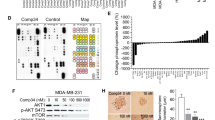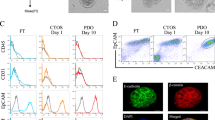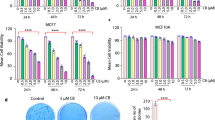Abstract
Drug resistance acquired by cancer cells has led to treatment failure. To understand the regulatory network underlying docetaxel resistance in breast cancer cells and to identify molecular targets for therapy, we tested small interfering RNAs (siRNAs) against 36 genes whose expression was elevated in human nonresponders to docetaxel for the ability to promote apoptosis of docetaxel-resistant human breast cancer cells (MCF7-ADR cells). The results indicate that the downregulation of the gene encoding ribopholin II (RPN2), which is part of an N-oligosaccharyl transferase complex, most efficiently induces apoptosis of MCF7-ADR cells in the presence of docetaxel. RPN2 silencing induced reduced glycosylation of the P-glycoprotein, as well as decreased membrane localization, thereby sensitizing MCF7-ADR cells to docetaxel. Moreover, in vivo delivery of siRNA specific for RPN2 markedly reduced tumor growth in two types of models for drug resistance. Thus, RPN2 silencing makes cancer cells hypersensitive response to docetaxel, and RPN2 might be a new target for RNA interference–based therapeutics against drug resistance.
This is a preview of subscription content, access via your institution
Access options
Subscribe to this journal
Receive 12 print issues and online access
$209.00 per year
only $17.42 per issue
Buy this article
- Purchase on Springer Link
- Instant access to full article PDF
Prices may be subject to local taxes which are calculated during checkout





Similar content being viewed by others
References
Kaufmann, M. et al. International expert panel on the use of primary (preoperative) systemic treatment of operable breast cancer: review and recommendations. J. Clin. Oncol. 21, 2600–2608 (2003).
Gradishar, W.J. et al. Neoadjuvant docetaxel followed by adjuvant doxorubicin and cyclophosphamide in patients with stage III breast cancer. Ann. Oncol. 16, 1297–1304 (2005).
Formenti, S.C. et al. Preoperative twice-weekly paclitaxel with concurrent radiation therapy followed by surgery and postoperative doxorubicin-based chemotherapy in locally advanced breast cancer: A phase I/II trial. J. Clin. Oncol. 21, 864–870 (2003).
Engels, F.K., Sparreboom, A., Mathot, R.A. & Verweij, J. Potential for improvement of docetaxel-based chemotherapy: a pharmacological review. Br. J. Cancer 93, 173–177 (2005).
Crown, J., O'Leary, M. & Ooi, W.S. Docetaxel & paclitaxel in the treatment of breast cancer: a review of clinical experience. Oncologist 9, 24–32 (2004).
Jones, S.E. et al. Randomized phase III study of docetaxel compared with paclitaxel in metastatic breast cancer. J. Clin. Oncol. 23, 5542–5551 (2005).
Bonneterre, J. et al. Efficacy and safety of docetaxel (Taxotere) in heavily pretreated advanced breast cancer patients: the French compassionate use programme experience. Eur. J. Cancer 35, 1431–1439 (1999).
Gottesman, M.M., Pastan, I. & Ambudkar, S.V. P-glycoprotein and multidrug resistance. Curr. Opin. Genet. Dev. 6, 610–617 (1996).
Duan, Z., Brakora, K.A. & Seiden, M.V. Inhibition of ABCB1 (MDR1) and ABCB4 (MDR3) expression by small interfering RNA and reversal of paclitaxel resistance in human ovarian cancer cells. Mol. Cancer Ther. 3, 833–838 (2004).
Leslie, E.M., Deeley, R.G. & Cole, S.P. Toxicological relevance of the multidrug resistance protein 1, MRP1 (ABCC1) and related transporters. Toxicology 167, 3–23 (2001).
Renes, J., de Vries, E.G., Jansen, P.L. & Muller, M. The (patho)physiological functions of the MRP family. Drug Resist. Updat. 3, 289–302 (2000).
Leonessa, F. & Clarke, R. ATP binding cassette transporters and drug resistance in breast cancer. Endocr. Relat. Cancer 10, 43–73 (2003).
Lin, J.C., Chang, S.Y., Hsieh, D.S., Lee, C.F. & Yu, D.S. The association of Id-1, MIF and GSTpi with acquired drug resistance in hormone independent prostate cancer cells. Oncol. Rep. 13, 983–988 (2005).
Galimberti, S., Testi, R., Guerrini, F., Fazzi, R. & Petrini, M. The clinical relevance of the expression of several multidrug-resistant–related genes in patients with primary acute myeloid leukemia. J. Chemother. 15, 374–379 (2003).
Burg, D., Riepsaame, J., Pont, C., Mulder, G. & van de Water, B. Peptide-bond modified glutathione conjugate analogs modulate GSTpi function in GSH-conjugation, drug sensitivity and JNK signaling. Biochem. Pharmacol. 71, 268–277 (2006).
Iwao-Koizumi, K. et al. Prediction of docetaxel response in human breast cancer by gene expression profiling. J. Clin. Oncol. 23, 422–431 (2005).
Kim, S.J. et al. High thioredoxin expression is associated with resistance to docetaxel in primary breast cancer. Clin. Cancer Res. 11, 8425–8430 (2005).
Kato, K. Adaptor-tagged competitive PCR: a novel method for measuring relative gene expression. Nucleic Acids Res. 25, 4694–4696 (1997).
Honma, K. et al. Atelocollagen-based gene transfer in cells allows high-throughput screening of gene functions. Biochem. Biophys. Res. Commun. 289, 1075–1081 (2001).
Honma, K., Miyata, T. & Ochiya, T. The role of atelocollagen-based cell transfection array in high-throughput screening of gene functions and in drug discovery. Curr. Drug Discov. Technol. 1, 287–294 (2004).
Minakuchi, Y. et al. Atelocollagen-mediated synthetic small interfering RNA delivery for effective gene silencing in vitro and in vivo. Nucleic Acids Res. 32, e109 (2004).
Takeshita, F. et al. Efficient delivery of small interfering RNA to bone-metastatic tumors by using atelocollagen in vivo. Proc. Natl. Acad. Sci. USA 102, 12177–12182 (2005).
Ochiya, T. et al. New delivery system for plasmid DNA in vivo using atelocollagen as a carrier material: the Minipellet. Nat. Med. 5, 707–710 (1999).
Ochiya, T., Nagahara, S., Sano, A., Itoh, H. & Terada, M. Biomaterials for gene delivery: atelocollagen-mediated controlled release of molecular medicines. Curr. Gene Ther. 1, 31–52 (2001).
Crimaudo, C., Hortsch, M., Gausepohl, H. & Meyer, D.I. Human ribophorins I and II: the primary structure and membrane topology of two highly conserved rough endoplasmic reticulum-specific glycoproteins. EMBO J. 6, 75–82 (1987).
Kelleher, D.J., Kreibich, G. & Gilmore, R. Oligosaccharyltransferase activity is associated with a protein complex composed of ribophorins I and II and a 48 kd protein. Cell 69, 55–65 (1992).
Kelleher, D.J. & Gilmore, R. An evolving view of the eukaryotic oligosaccharyltransferase. Glycobiology 16, 47R–62R (2006).
Loo, T.W., Bartlett, M.C. & Clarke, D.M. The dileucine motif at the COOH terminus of human multidrug resistance P-glycoprotein is important for folding but not activity. J. Biol. Chem. 280, 2522–2528 (2005).
Ochiya, T., Honma, K., Takeshita, F. & Nagahara, S. Atelocollagen-mediated drug discovery technology. Expert Opin. Drug Discov. 2, 159–167 (2007).
Tsuruo, T. et al. Molecular targeting therapy of cancer: drug resistance, apoptosis and survival signal. Cancer Sci. 94, 15–21 (2003).
Schinkel, A.H., Kemp, S., Dolle, M., Rudenko, G. & Wagenaar, E. N-glycosylation and deletion mutants of the human MDR1 P-glycoprotein. J. Biol. Chem. 268, 7474–7481 (1993).
Kramer, R. et al. Inhibition of N-linked glycosylation of P-glycoprotein by tunicamycin results in a reduced multidrug resistance phenotype. Br. J. Cancer 71, 670–675 (1995).
Bentley, J., Quinn, D.M., Pitman, R.S., Warr, J.R. & Kellett, G.L. The human KB multidrug-resistant cell line KB-C1 is hypersensitive to inhibitors of glycosylation. Cancer Lett. 115, 221–227 (1997).
Zhang, Z., Wu, J.Y., Hait, W.N. & Yang, J.M. Regulation of the stability of P-glycoprotein by ubiquitination. Mol. Pharmacol. 66, 395–403 (2004).
O'Brian, C.A., Ward, N.E., Stewart, J.R. & Chu, F. Prospects for targeting protein kinase C isozymes in the therapy of drug-resistant cancer—an evolving story. Cancer Metastasis Rev. 20, 95–100 (2001).
Zhan, M. et al. Transcriptional repression of protein kinase Cα via Sp1 by wild type p53 is involved in inhibition of multidrug resistance 1 P-glycoprotein phosphorylation. J. Biol. Chem. 280, 4825–4833 (2005).
Nieth, C., Priebsch, A., Stege, A. & Lage, H. Modulation of the classical multidrug resistance (MDR) phenotype by RNA interference (RNAi). FEBS Lett. 545, 144–150 (2003).
Wu, H., Hait, W.N. & Yang, J.M. Small interfering RNA–induced suppression of MDR1 (P-glycoprotein) restores sensitivity to multidrug-resistant cancer cells. Cancer Res. 63, 1515–1519 (2003).
Muller, C., Laurent, G. & Ling, V. P-glycoprotein stability is affected by serum deprivation and high cell density in multidrug-resistant cells. J. Cell. Physiol. 163, 538–544 (1995).
Pommier, Y., Sordet, O., Antony, S., Hayward, R.L. & Kohn, K.W. Apoptosis defects and chemotherapy resistance: molecular interaction maps and networks. Oncogene 23, 2934–2949 (2004).
Sordet, O., Khan, Q.A., Kohn, K.W. & Pommier, Y. Apoptosis induced by topoisomerase inhibitors. Curr. Med. Chem. Anticancer Agents 3, 271–290 (2003).
Schott, A.F., Apel, I.J., Nunez, G. & Clarke, M.F. Bcl-XL protects cancer cells from p53-mediated apoptosis. Oncogene 11, 1389–1394 (1995).
Walczak, H., Bouchon, A., Stahl, H. & Krammer, P.H. Tumor necrosis factor-related apoptosis-inducing ligand retains its apoptosis-inducing capacity on Bcl-2– or Bcl-xL–overexpressing chemotherapy-resistant tumor cells. Cancer Res. 60, 3051–3057 (2000).
Reed, J.C. Apoptosis-based therapies. Nat. Rev. Drug Discov. 1, 111–121 (2002).
Lytle, R.A., Jiang, Z., Zheng, X. & Rich, K.M. BCNU down-regulates anti-apoptotic proteins Bcl-xL and Bcl-2 in association with cell death in oligodendroglioma-derived cells. J. Neurooncol. 68, 233–241 (2004).
Jiang, Z., Zheng, X. & Rich, K.M. Down-regulation of Bcl-2 and Bcl-xL expression with bispecific antisense treatment in glioblastoma cell lines induce cell death. J. Neurochem. 84, 273–281 (2003).
Guensberg, P. et al. Bcl-xL antisense oligonucleotides chemosensitize human glioblastoma cells. Chemotherapy 48, 189–195 (2002).
Tran, N.L. et al. The tumor necrosis factor–like weak inducer of apoptosis (TWEAK)-fibroblast growth factor–inducible 14 (Fn14) signaling system regulates glioma cell survival via NFκB pathway activation and BCL-XL/BCL-W expression. J. Biol. Chem. 280, 3483–3492 (2005).
Li, Y. et al. Inactivation of nuclear factor κB by soy isoflavone genistein contributes to increased apoptosis induced by chemotherapeutic agents in human cancer cells. Cancer Res. 65, 6934–6942 (2005).
Vergniol, J.C., Bruno, R., Montay, G. & Frydman, A. Determination of Taxotere in human plasma by a semi-automated high-performance liquid chromatographic method. J. Chromatogr. 582, 273–278 (1992).
Acknowledgements
Human mammary carcinoma cell lines, MCF7 cells and multidrug-resistant MCF7-ADR cells were provided by Shien-Lab, Medical Oncology, National Cancer Center Hospital of Japan. We gratefully thank S. Noguchi for the initiation of the whole project and for helpful discussion. We also thank H. Inaji, K. Yoshioka and K. Itoh for their kind assistance; J. Miyazaki (Osaka University) for the kind gift of CAG promoter; and A. Inoue and M. Wada for their excellent technical work. This work was supported in part by a grant-in-aid for the Third-Term Comprehensive 10-Year Strategy for Cancer Control of Japan; a grant-in-aid for Scientific Research on Priority Areas Cancer from the Japanese Ministry of Education, Culture, Sports, Science and Technology; and the Program for Promotion of Fundamental Studies in Health Sciences of the National Institute of Biomedical Innovation of Japan.
Author information
Authors and Affiliations
Contributions
K.H. performed the experimental work, data analysis and writing of the first draft of the manuscript. K.K. and T.O. selected the initial set of genes subjected to the screening. K.I.-K., K.K., T.Y. and T.O. participated in the conception, design and coordination of the study. F.T. and Y.Y. performed siRNA delivery in vivo and helped with data analysis. K.N. provided drug-resistant cell lines. S.N. provided delivery molecules. The manuscript was finalized by T.O. with the assistance of all authors.
Corresponding author
Supplementary information
Supplementary Text and Figures
Supplementary Figs. 1–6, Supplementary Methods, Supplementary Table 1–2, and Supplementary Note (PDF 489 kb)
Rights and permissions
About this article
Cite this article
Honma, K., Iwao-Koizumi, K., Takeshita, F. et al. RPN2 gene confers docetaxel resistance in breast cancer. Nat Med 14, 939–948 (2008). https://doi.org/10.1038/nm.1858
Received:
Accepted:
Published:
Issue Date:
DOI: https://doi.org/10.1038/nm.1858
This article is cited by
-
Overexpression of RPN2 suppresses radiosensitivity of glioma cells by activating STAT3 signal transduction
Molecular Medicine (2020)
-
RPN2 is targeted by miR-181c and mediates glioma progression and temozolomide sensitivity via the wnt/β-catenin signaling pathway
Cell Death & Disease (2020)
-
Silencing Myostatin Using Cholesterol-conjugated siRNAs Induces Muscle Growth
Molecular Therapy - Nucleic Acids (2016)
-
Somatic gene copy number alterations in colorectal cancer: new quest for cancer drivers and biomarkers
Oncogene (2016)
-
Integrated transcriptional profiling and genomic analyses reveal RPN2 and HMGB1 as promising biomarkers in colorectal cancer
Cell & Bioscience (2015)



